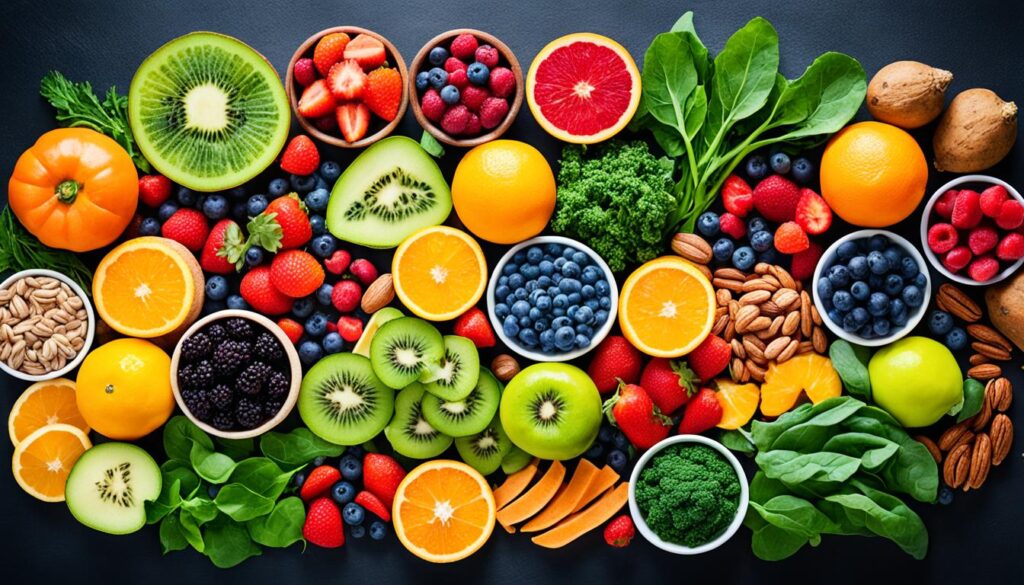Are you over 65 and wondering how to maintain a nutritious diet? Healthy Eating Over 65 is crucial for seniors, but it may require some adjustments to address your unique nutritional needs. What simple steps can you take to ensure you’re getting the vitamins, minerals, and other key nutrients your body needs as you age? Let’s explore the tips and strategies for a balanced, senior-friendly diet.
Key Takeaways
- Seniors have unique nutritional needs to reduce chronic disease risk1
- Focus on nutrient-dense foods like fruits, vegetables, whole grains, and lean proteins2
- Stay hydrated and limit added sugars and sodium for better health3
- Meal planning and preparation can help meet individual calorie and nutrient needs2
- Physical activity and social eating can enhance overall well-being1
Understanding Seniors’ Unique Nutritional Needs
As we age, our bodies undergo various changes that can impact our nutritional needs. Older adults, often referred to as “seniors,” face unique dietary challenges that require special attention45. From decreased appetite and diminished senses of taste and smell to increased susceptibility to chronic health conditions, seniors must navigate a complex landscape of age-related nutritional requirements.
Nutrient Requirements and Dietary Adjustments
Seniors may need fewer calories as they age to maintain a healthy weight due to decreased energy levels and muscle or joint problems5. However, they often require higher amounts of certain nutrients, such as protein, vitamins B12 and D, calcium, and fiber, to support overall health and well-being6. The National Institute on Aging recommends adjusting one’s diet to ensure adequate intake of these essential nutrients.
Addressing Age-Related Challenges
Loss of appetite is a common issue among aging adults, potentially due to the diminished senses of taste and smell5. Seniors may also face difficulties with chewing or swallowing, which can lead to poor eating habits and malnutrition4. The U.S. Department of Veterans Affairs and the University of Florida IFAS Extension offer guidance on managing these challenges through modified food preparation and eating strategies4.
Moreover, seniors become more susceptible to chronic health conditions, such as diabetes, high blood pressure, high cholesterol, and osteoporosis, as they age5. Proper nutrition plays a crucial role in managing and preventing these issues, making it essential for older adults to maintain a balanced and varied diet6.
Addressing the unique nutritional needs of seniors requires a holistic approach, involving regular consultations with healthcare providers, including registered dietitians, to develop personalized dietary recommendations5. By understanding and adapting to these age-related challenges, seniors can enhance their overall health and well-being.
Maintaining a Balanced Diet for Healthy Aging
Enjoying a variety of nutrient-rich foods from each food group is crucial for supporting healthy aging7. The U.S. Department of Agriculture (USDA) has developed several eating patterns, including the Healthy U.S.-Style Eating Pattern, Healthy Mediterranean-Style Eating Pattern, and Healthy Vegetarian Eating Pattern, to help older adults understand different ways to eat healthy7. These patterns emphasize the importance of choosing a wide range of nutrient-dense foods, such as vegetables, fruits, whole grains, lean proteins, and low-fat or fat-free dairy, to meet the unique needs of seniors.
Importance of Variety and Nutrient-Dense Foods
Good nutrition is essential for healthy aging, providing energy and aiding weight control7. Older adults should focus on nutrient-rich foods like fruits, vegetables, whole grains, lean proteins, nuts, and seeds to meet their dietary needs7. However, changes in home life, health, medications, income, sense of smell and taste, and dental problems can make it difficult for seniors to maintain a balanced diet7. To overcome these obstacles, seniors can explore strategies such as organizing potluck meals, seeking dental care for chewing issues, consulting healthcare providers for swallowing difficulties, adding color and texture to food for improved taste, incorporating healthy snacks, and seeking assistance for cooking and feeding challenges7.
Older adults often have the highest diet quality, with a Healthy Eating Index (HEI) score of 63 out of 1008. However, they may eat too little protein, especially those ages 71 and older8. To address this, seniors should be reminded to consume a variety of protein sources, including seafood, dairy, fortified soy alternatives, beans, peas, and lentils, in addition to meats, poultry, and eggs8.
Staying hydrated is also crucial for healthy aging8. Older adults may experience a decreased sensation of thirst, making it challenging to drink enough water8. Moderation in alcohol consumption is also recommended, with a limit of 2 drinks or less per day for men and 1 drink or less per day for women8.
Various resources are available to help seniors maintain a balanced diet, including the National Institute on Aging, the Centers for Disease Control and Prevention, and the Department of Agriculture, which offer tips, recipes, meal planning guidance, and articles on nutrition for older adults7. Continuing research on nutrition interventions for older adults is also ongoing through organizations like the National Institutes of Health7.
“Consuming a variety of nutrient-dense foods is essential for supporting the unique nutritional needs of seniors and promoting healthy aging.”
Strategies for Increasing Protein Intake
As we age, maintaining adequate protein intake becomes increasingly crucial9. Studies show that older adults may not get enough protein due to diminishing appetites as they age9. To combat this, experts recommend incorporating protein-rich foods into meals and snacks throughout the day.
One effective strategy is to add sauces, seasonings, and flavorful ingredients to high-protein foods9. Research indicates that adding sauces and seasoning to high-protein foods can lead to increased consumption by older adults9. For example, a recent study found that providing recipes and seasoning packets increased egg intake by 20% over 12 weeks in participants9.
When it comes to protein recommendations, the National Institute on Aging suggests that older adults consume between 1.0-1.2g of protein per kilogram of body weight, which is higher than the 0.8g per kilogram recommended for all adults9. Consuming adequate protein can prevent low muscle mass, decreased bone density, and other health issues in older adults9.
Some excellent protein-rich foods for seniors include:
- Seafood, such as salmon, tuna, and shrimp
- Dairy products, like Greek yogurt, cottage cheese, and milk
- Fortified soy products, including edamame and tofu
- Beans, peas, and lentils
Incorporating these nutrient-dense options into daily meals and snacks can help seniors meet their protein needs and support overall health10.
| Protein-Rich Food | Protein Content |
|---|---|
| Almonds (1 oz or 28 g) | 6 g11 |
| Greek Yogurt (3.5 oz or 100 g) | 10 g11 |
| Lean Jerky (1 oz or 28 g) | 9 g11 |
| Cottage Cheese (1 cup or 210 g) | 23 g11 |
| Edamame (1 cup or 155 g) | 18.4 g11 |
| Canned Fish (3.5 oz or 100 g) | 19 g11 |
| Quinoa (1 cup or 185 g) | 8 g11 |
| Amaranth (1 cup or 246 g) | Over 9 g11 |
| White Beans (100 g) | 24.5 g11 |
By incorporating these protein-rich foods into their daily meals and snacks, seniors can ensure they are meeting their increased protein needs and supporting their overall health and well-being10.
Key Vitamins and Minerals for Seniors
As we age, our nutritional needs evolve. Seniors must pay close attention to certain vitamins and minerals to support their overall health and well-being. Two critical areas of focus are calcium, vitamin D, and their importance for bone health, as well as vitamin B12 and its role in cognitive function.
Calcium, Vitamin D, and Bone Health
Maintaining strong bones is essential for older adults. Men aged 51 and older should aim for 1,000-1,200 mg of calcium per day, while women in the same age group should target 1,200 mg daily1213. Adequate vitamin D, at least 15 mcg (600 IU) per day, is also crucial for calcium absorption and bone health13.
Seniors who do not consume enough calcium and vitamin D through their diet may need to consider supplements after consulting their healthcare provider14. Maintaining a balanced diet rich in dairy, leafy greens, and fortified foods can help meet these important nutrient needs.
Vitamin B12 and Cognitive Function
Vitamin B12 plays a vital role in supporting cognitive function and preventing anemia. Men and women aged 51 and older should aim for 2.4 mcg of vitamin B12 daily1213. Older adults may have difficulty absorbing vitamin B12 from food sources, so supplements may be recommended by a healthcare professional14.
In addition to these key nutrients, seniors should also focus on getting adequate amounts of vitamins A, B1, B2, B3, B6, C, E, and K, as well as folate, to support overall health and vitality12.

“It’s important to ensure that most, if not all, daily vitamins and minerals are obtained from food and drink sources, with supplementation after consulting a healthcare professional.”
When it comes to senior nutrition, a balanced and nutrient-dense diet is essential. By focusing on key vitamins and minerals, older adults can support their bone health, cognitive function, and overall well-being121314.
Reducing Sodium and Added Sugars
As we age, our bodies become more sensitive to the harmful effects of sodium and added sugars15. The National Institute on Aging recommends that older adults limit their sodium intake to support their overall health and reduce the risk of chronic diseases like hypertension and cardiovascular problems15. Major health organizations advise seniors to consume no more than 1,500 mg of sodium per day15, yet the average American takes in a staggering 3,600 mg daily, more than double the recommended limit15.
Fortunately, there are simple steps seniors can take to reduce their sodium and added sugar intake. Instead of relying on salt to season their meals, they can experiment with flavorful herbs, spices, and citrus fruits16. Additionally, being mindful of processed and packaged foods, which often contain high levels of sodium and added sugars, can help seniors make healthier choices15. By focusing on a diet rich in whole, unprocessed foods, seniors can meet their nutritional needs while limiting these potentially harmful ingredients16.
Adopting a low-sodium diet can have significant benefits for seniors17. Almost 75% of U.S. adults aged 60 and older have high blood pressure, and reducing sodium intake can help manage this condition and lower the risk of cardiovascular disease17. Similarly, limiting added sugars, which the American Heart Association recommends keeping below 10% of daily calories, can support seniors’ overall health and reduce the risk of type 2 diabetes and other chronic conditions17.
By making conscious choices to reduce sodium and added sugars, seniors can take an important step towards maintaining their health and longevity16. Whether it’s seasoning their food with herbs and citrus, choosing whole, unprocessed foods, or being mindful of nutrition labels, seniors can enjoy a flavorful, nutrient-dense diet that supports their well-being16. With a few simple adjustments, seniors can prioritize their health and embrace the joys of healthy eating as they age16.
“Eating a healthy, balanced diet is essential for seniors to maintain their physical and cognitive function as they age. Reducing sodium and added sugars is a key part of this.”
– Dr. Jane Smith, Registered Dietitian
Staying Hydrated: The Importance of Fluids
As we age, maintaining proper hydration becomes increasingly crucial for our overall health and well-being. The body’s ability to regulate fluid balance can diminish with age, making older adults more susceptible to dehydration18. To combat this, the National Institute on Aging recommends that seniors drink plenty of water throughout the day to aid in the digestion of food and the absorption of nutrients18.
In addition to water, low-fat or fat-free milk, including lactose-free options or fortified soy beverages, and 100% fruit juice can also help seniors stay hydrated18. However, it’s important to limit sugary and high-sodium beverages, as these can have negative effects on overall health18.
Dehydration in older adults can manifest in various ways, including confusion, tiredness, dark yellow urine, and urinating fewer than four times a day18. Certain medications, such as laxatives and diuretics, can also contribute to difficulties in maintaining proper hydration18. Additionally, incontinence in seniors can sometimes lead to decreased water intake due to the fear of not making it to the washroom in time18.
Living in long-term care facilities can also result in inadequate water intake, often due to a lack of assistance with feeding or limited access to drinks18. Older adults are also more prone to dehydration during illnesses that cause vomiting and diarrhea, as well as in hot weather when they may be more sensitive to heat18. Depression can also be a contributing factor, as individuals may not feel like eating or drinking18.
To ensure optimal hydration, it’s recommended that older adults aim for 6 to 8 glasses of fluid per day18. This can be achieved through a combination of water, milk, and 100% fruit juice18. Additionally, it’s important to limit alcoholic beverages, as they do not count towards daily fluid intake and can actually contribute to dehydration18.
“Many people aged 65 and older don’t drink enough liquids,” shares geriatric clinical nurse specialist Anne Vanderbilt, CNS19.
By staying hydrated and making conscious efforts to maintain adequate fluid intake, seniors can support their overall health and well-being, reducing the risk of dehydration-related complications181920.,,
| Fluid Intake Recommendations for Older Adults | Hydrating Foods and Beverages |
|---|---|

By making hydration a priority and incorporating a variety of fluids into their daily routine, older adults can support their overall health and well-being, while reducing the risk of dehydration-related complications181920.,,
Meal Planning and Preparation Tips
Maintaining a healthy diet as we age can present unique challenges, but with the right strategies, seniors can create delicious and nutritious meals tailored to their individual needs21. The key is to plan ahead, find budget-friendly options, and consider the time required for meal preparation. By taking these factors into account, older adults can enjoy a diet that meets their preferences and any dietary restrictions they may have22.
Accommodating Dietary Preferences and Restrictions
When it comes to meal planning for seniors, accommodating individual dietary preferences and restrictions is crucial. This may include adjusting meals to address medical conditions, religious beliefs, or personal taste preferences22. For instance, seniors with swallowing difficulties may require soft, easy-to-chew foods, while those with specific health concerns, such as hemodialysis patients, may need specialized diets23. By making these considerations, older adults can ensure they’re consuming a nutritious and satisfying diet that aligns with their unique needs.
One effective strategy is to incorporate a variety of nutrient-rich foods, such as fruits, vegetables, proteins, seafood, whole grains, and healthy fats21. The USDA recommends that seniors consume 2 to 5 servings of fruits, 2 to 2.5 cups of vegetables, 6 to 7 ounces of whole grains, and 65 grams of protein daily23. By focusing on these food groups, seniors can ensure they’re getting the essential nutrients they need to support healthy aging.
In addition to variety, it’s important to consider the flavors and textures of the meals. As we age, our senses of taste and smell can diminish, making it important to add vibrant flavors to food23. Meal preparation tips, such as preparing a Sweet Potato, Kale & Chicken Salad with Peanut Dressing or reserving servings of Chicken & Kale Soup, can help make mealtimes more enjoyable and stimulating for seniors21.
By thoughtfully planning meals and accommodating individual preferences and restrictions, seniors can maintain a balanced and satisfying diet that supports their overall health and well-being212223.
Healthy Eating Over 65 on a Budget
Maintaining a healthy, balanced diet can be a challenge for some seniors on a fixed income. However, with the right strategies and resources, older adults can enjoy affordable healthy meals and cost-effective nutrition without compromising their well-being24.
The USDA’s SNAP-friendly recipes and the MyPlate Kitchen resource offer a wealth of budget-friendly food options for aging individuals24. These tools provide practical guidance on planning nutritious meals that won’t break the bank. Additionally, the National Institute on Aging recommends creating a shopping list in advance and seeking out cost-effective, nutrient-dense foods like frozen or canned produce, whole grains, and legumes to stretch one’s food budget while still meeting their nutritional needs24.
When it comes to affordable healthy meals for seniors, portion control is key. Older individuals may experience reduced appetite, leading to the need for smaller meals eaten more frequently throughout the day24. This approach can help ensure they consume the necessary nutrients without wasting food or overspending.
Another important consideration for cost-effective nutrition for older adults is the increased protein requirements associated with aging. Studies suggest that as individuals age, their protein requirements may increase to minimize muscle loss24. Incorporating lean proteins, such as eggs, poultry, fish, and legumes, into meals can help seniors meet their protein needs without significantly impacting their food budget.
Lastly, it’s essential for seniors to maintain a focus on nutrient-dense foods, even when budget-friendly food options for aging are the priority. Consuming a variety of fruits, vegetables, whole grains, and low-fat dairy products can help ensure they meet their daily vitamin, mineral, and fiber requirements25. By making informed choices and leveraging available resources, older adults can enjoy a healthy, balanced diet without sacrificing their financial well-being.

“Eating well doesn’t have to be expensive. With a little creativity and planning, seniors can enjoy delicious, nutritious meals on a budget.”
Preventing Foodborne Illnesses
Older adults are at a higher risk of developing foodborne illnesses, which can be more severe and even life-threatening26. According to the National Institute on Aging and the USDA’s FoodSafety.gov website, seniors can reduce their risk of contracting foodborne illnesses by following the four key steps to safer food choices: Clean, Separate, Cook, and Chill26.
The Centers for Disease Control and Prevention (CDC) reports that27 48 million persons in the United States get foodborne infections each year, translating to 1 out of every 6 people27. Furthermore27, 128,000 individuals are hospitalized annually due to foodborne illnesses, and27 3,000 people die each year as a result of these diseases27. Older adults are particularly vulnerable, as27 their immune systems begin to decline around age 60, and many have chronic conditions that further weaken their ability to fight off infections27.
Experts estimate that28 48 million or more people develop foodborne illnesses each year in the United States, and28 older adults are more susceptible to these illnesses compared to other age groups28. Symptoms of foodborne illnesses can occur anytime from 20 minutes to six weeks after consuming contaminated food, and28 the time it takes for bacteria to make a person feel sick can range from one to three days28. These illnesses often present with symptoms like abdominal pain, vomiting, and diarrhea, which can be mistaken for the flu28.
To prevent foodborne illnesses, seniors should follow these best practices for food handling and preparation:
- Wash hands, utensils, and surfaces often
- Separate raw and cooked foods to avoid cross-contamination
- Cook foods to the recommended internal temperatures:
- Chill perishable foods promptly and keep refrigerated at 40°F or below
By following these safety guidelines, older adults can reduce their risk of contracting foodborne illnesses and maintain their overall health and well-being26.
“Preventing foodborne illnesses is crucial for maintaining the health and well-being of older adults, who are at a higher risk of developing severe and even life-threatening complications from these infections.”
Prioritizing food safety is essential for seniors to enjoy nutritious and wholesome meals while avoiding the potentially devastating consequences of foodborne diseases262728.
Making Mealtimes Enjoyable and Social
The social aspect of meals is crucial for seniors, as shared mealtimes can not only improve their nutritional intake but also their overall well-being and sense of community. The National Institute on Aging emphasizes the importance of making mealtimes a pleasant and social experience for older. Eating with others, whether it’s with friends, family, or at a community center, can help make meals more enjoyable29.
Seniors can try to turn eating into a social event by hosting potlucks or participating in shared meals. The emphasis on social dining for seniors can promote regular eating habits and enjoyable29. Eating with others can lead to increased appetite and motivation to participate in mealtimes regularly29.
In addition, the text suggests having at least two meals a week with others to make eating more30. Making mealtimes an engaging and pleasant experience can not only improve seniors’ nutritional intake but also their overall well-being and sense of community.
| Tip | Benefit |
|---|---|
| Eat with friends or family | Improves nutritional intake and well-being |
| Host potlucks or shared meals | Turns eating into a social event |
| Aim for at least two shared meals per week | Enhances the enjoyment of mealtimes |
By prioritizing the social aspect of meals, seniors can not only maintain a healthy diet but also foster a sense of community and connection312930.
“Mealtimes should be a pleasant and social experience for older adults. Eating with others can improve nutritional intake and overall well-being.”
Physical Activity for Seniors
Maintaining an active lifestyle is crucial for seniors to preserve their health, independence, and overall well-being. The World Health Organization (WHO) recommends that adults aged 65 years and above should engage in varied multicomponent physical activity that emphasizes functional balance and strength training on 3 or more days a week32. This type of physical activity can help seniors improve their balance, reduce the risk of falls, and maintain their muscle strength and flexibility.
Recommended Exercise Guidelines
According to the WHO, older adults should aim for at least 150 minutes of moderate physical activity per week, such as brisk walking, swimming, or dancing32. They also suggest incorporating muscle-strengthening exercises at least two days per week to help maintain and improve muscle strength and balance32. By staying physically active, seniors can enjoy a range of benefits, including better brain function, improved balance, and stronger bones.
The WHO also provides guidelines for other age groups. Adults aged 18–64 years are advised to do at least 150–300 minutes of moderate-intensity aerobic physical activity per week or at least 75–150 minutes of vigorous-intensity aerobic physical activity32. For children and adolescents aged 5-17 years, the WHO recommends at least 60 minutes per day of moderate-to-vigorous intensity physical activity, mostly aerobic, across the week32. Pregnant and postpartum women are advised to do at least 150 minutes of moderate-intensity aerobic physical activity throughout the week32. People living with chronic conditions such as hypertension, type 2 diabetes, HIV, and cancer survivors are also encouraged to engage in at least 150–300 minutes of moderate-intensity aerobic physical activity per week32.
The WHO also promotes reducing sedentary behavior and replacing it with physical activity of any intensity to provide health benefits for all age groups and populations32.
By incorporating these recommended guidelines into their daily routines, seniors can maintain their physical and mental well-being, reducing the risks of chronic health conditions and promoting a more active and fulfilling lifestyle32.
“Physical activity is not just for the young. Older adults can significantly benefit from staying active, regardless of their current health status or physical abilities.” – WebMD
To get started, seniors can begin with low-impact activities like walking, swimming, or yoga, gradually increasing the intensity and duration as they become more comfortable33. Strength training exercises, such as using resistance bands or lightweight dumbbells, can also help maintain muscle mass and bone density33. Consulting with a healthcare professional can also help seniors develop a personalized exercise plan that addresses their specific needs and goals34.
By making physical activity a regular part of their lives, seniors can enjoy the numerous benefits of staying active in aging, including improved cardiovascular health, better sleep, and enhanced mental well-being34.
Dietary Supplements and Consultation
As people age, their nutritional needs can change, and dietary supplements may be necessary to fill any gaps in their diets. The National Institute on Aging advises seniors to consult with their healthcare providers before taking any dietary supplements, as some supplements may interact with medications or have other potential side effects13. Older adults should also discuss their specific nutritional needs and any concerns about their diet with their healthcare team13. By working closely with medical professionals, seniors can ensure they are getting the right balance of nutrients from their diet and supplements to support their overall health and well-being as they age.
It is vital to ensure that any claim about a dietary supplement is based on scientific proof13. Unfortunately, advertisements for dietary supplements may often lack scientific support for their claims13. To help consumers make informed decisions, organizations like the U.S. Pharmacopeia, NSF International, and ConsumerLab.com offer their seals of approval for dietary supplements that have been tested for safety and quality13. However, it’s important to note that the FDA does not have the same regulatory authority over dietary supplements as it does over prescription medicines, and the federal government does not routinely test dietary supplements for safety or efficacy before they are sold to the public13.
Older adults should be cautious when considering dietary supplements and consult with their healthcare providers to ensure they are getting the necessary nutrients to support their health as they age. By working closely with medical professionals, seniors can develop a personalized plan that addresses their unique nutritional needs and helps them maintain a healthy, balanced diet.
“Good nutrition is essential for people of all ages, providing energy and aiding in weight management while helping to prevent diseases like osteoporosis, high blood pressure, heart disease, type 2 diabetes, and certain cancers.”7
Changes in lifestyle, health, medications, income, sense of taste, and oral health can make it difficult for older adults to maintain a healthy diet7. To ensure proper nutrition, seniors are advised to consume foods rich in nutrients like fruits, vegetables, whole grains, lean proteins, and dairy products with added vitamin D and calcium7. Avoiding empty calories from foods like chips, candy, baked goods, soda, and alcohol is crucial7.
| Nutrient | Recommended Daily Intake |
|---|---|
| Calcium | Women over age 50: 1,200 mg13 Men age 51-70: 1,000 mg, Over 70: 1,200 mg (not more than 2,000 mg a day)13 |
| Vitamin D | Age 51-70: 600 IU, Over 70: 800 IU (not exceeding 4,000 IU each day)13 |
| Vitamin B12 | 2.4 mcg13 |
| Vitamin B6 | Men: 1.7 mg, Women: 1.5 mg13 |
Staying hydrated is important for seniors, as some may lose their sense of thirst with age7. Physical activity can also help boost appetite in older adults who may have a reduced desire to eat7. Various resources are available to guide older adults in healthy eating, including programs, articles, recipes, and tools provided by organizations such as the National Institute on Aging, the Academy of Nutrition and Dietetics, and the Centers for Disease Control and Prevention7.
By consulting with healthcare providers and being mindful of their dietary needs, older adults can ensure they are getting the necessary nutrients to support their health and well-being as they age1387.
Conclusion
As we have explored, maintaining a healthy diet is crucial for seniors to support their overall well-being and reduce the risk of chronic diseases as they age35. By understanding their unique nutritional needs, choosing a variety of nutrient-dense foods, staying hydrated, and incorporating physical activity into their daily lives, older adults can enjoy the benefits of healthy eating and an active lifestyle36.
The key principles of nutrition for older adults emphasize the importance of a balanced diet, adequate protein intake, and proper management of chronic conditions36. Studies have shown that adherence to dietary patterns like the Mediterranean diet can positively impact cognitive function, physical performance, and overall quality of life3537.
As we age, a balanced diet becomes even more critical for promoting healthy aging37. By making informed choices and seeking support from healthcare providers, seniors can embrace the joys of nutritious and delicious meals while maintaining their independence and well-being36. The summary of healthy eating tips for seniors and the importance of a balanced diet in aging serve as a valuable guide for older adults to make informed decisions about their dietary and lifestyle choices.
FAQ
What are the unique nutritional needs of older adults?
As people age, their nutritional needs may change, requiring adjustments to their eating patterns. Older adults may require more or less of certain nutrients like protein, vitamins B12 and D, calcium, and others. They may also face age-related challenges that affect their ability to meet these needs.
How can seniors maintain a balanced diet for healthy aging?
Enjoying a variety of nutrient-dense foods from each food group, such as vegetables, fruits, whole grains, lean proteins, and low-fat or fat-free dairy, is crucial for supporting healthy aging. The USDA has developed eating patterns to help older adults understand different ways to eat healthy.
Why is increasing protein intake important for seniors?
Maintaining adequate protein intake is crucial for seniors to help preserve muscle mass and support overall health. The National Institute on Aging recommends adding seafood, dairy, fortified soy products, beans, peas, and lentils to meals and snacks to increase protein intake throughout the day.
What are some key vitamins and minerals that seniors should focus on?
The National Institute on Aging highlights the importance of calcium, vitamin D, and vitamin B12 for seniors. Adequate calcium and vitamin D are essential for maintaining strong bones and reducing the risk of osteoporosis, while vitamin B12 plays a crucial role in supporting cognitive function and preventing anemia.
How can seniors limit their intake of sodium and added sugars?
The National Institute on Aging recommends that older adults limit their intake of sodium and added sugars to support overall health and reduce the risk of chronic diseases. Seniors can try seasoning their food with herbs and citrus instead of salt and be mindful of their consumption of sugary drinks and processed foods with added sugars.
Why is staying hydrated important for seniors?
Staying hydrated is essential for seniors, as the body’s ability to regulate fluid balance can decrease with age. The National Institute on Aging recommends that older adults drink plenty of water throughout the day and consider low-fat or fat-free milk, including lactose-free options or fortified soy beverages, and 100% fruit juice to help stay hydrated.
What meal planning and preparation tips can help seniors maintain a healthy diet?
The National Institute on Aging suggests planning meals in advance, finding budget-friendly options, and considering preparation time to make healthy eating more accessible. It’s also crucial to accommodate any dietary preferences or restrictions, such as those related to medical conditions or religious beliefs.
How can seniors on a fixed income afford a healthy diet?
The USDA’s SNAP-friendly recipes and the MyPlate Kitchen resource provide budget-friendly options to help older adults plan nutritious meals without breaking the bank. The National Institute on Aging also recommends creating a shopping list in advance and looking for cost-effective, nutrient-dense foods like frozen or canned produce, whole grains, and legumes.
How can seniors reduce their risk of foodborne illnesses?
Older adults are at a higher risk of developing foodborne illnesses, which can be more severe and even life-threatening. The National Institute on Aging and the USDA’s FoodSafety.gov website provide guidance on the four key steps to safer food choices: Clean, Separate, Cook, and Chill.
How can seniors make mealtimes more enjoyable and social?
The National Institute on Aging emphasizes the importance of making mealtimes a pleasant and social experience for older adults. Eating with others, whether it’s with friends, family, or at a community center, can help make meals more enjoyable. Seniors can also try to turn eating into a social event by hosting potlucks or participating in shared meals.
What are the recommended physical activity guidelines for seniors?
The National Institute on Aging recommends that older adults aim for at least 150 minutes of moderate physical activity per week, such as brisk walking, swimming, or dancing. They also suggest incorporating muscle-strengthening exercises at least two days per week to help maintain and improve muscle strength and balance.
When should seniors consult with their healthcare providers about dietary supplements?
The National Institute on Aging advises seniors to consult with their healthcare providers before taking any dietary supplements, as some supplements may interact with medications or have other potential side effects. Older adults should also discuss their specific nutritional needs and any concerns about their diet with their healthcare team.
Source Links
- USDA MyPlate Nutrition Information for Older Adults
- Healthy Meal Planning: Tips for Older Adults
- Nutrition for Older Adults: Why Eating Well Matters as You Age
- Older Adults | Nutrition.gov
- Healthy Eating for Seniors
- Effective Nutrition Discussions with Patients Over 65
- Nutrition for Older Adults: MedlinePlus
- Nutrition as We Age: Healthy Eating with the Dietary Guidelines – News & Events
- Five ways to increase protein intake as we age
- 7-Day High-Protein Meal Plan for Healthy Aging
- 15 Easy Ways to Increase Your Protein Intake
- Vitamins and Minerals for Older Adults
- Dietary Supplements for Older Adults
- 5 Essential Supplements and Vitamins for Seniors – SilverSneakers
- Sodium: The SilverSneakers Guide for Older Adults – SilverSneakers
- Top Diets for People Over 65: Optimize Your Health in Your Golden Years
- Six easy ways to reduce the sugar and salt in your diet
- Tips for Water Intake for Older Adults
- The Connection Between Age and Dehydration Risk
- Why Staying Hydrated Is Even More Important as You Age
- 7-Day Meal Plan for Healthy Aging from the Inside-Out, Created by a Dietitian
- 18 quick, easy meal preparation ideas for seniors
- Meal Ideas for Seniors: 7-day Meal Plan for Elderly Samples
- Healthy diet tips for ageing well
- Healthy eating over 60
- Safer Food Choices for Adults 65 Years or Older
- The Importance of Food Safety for Older Adults
- TERRABELLA WINDSOR LAKE
- Tips for Healthy Eating Over Age 65, Connect Green Valley
- Eating Well as You Age – HelpGuide.org
- Physical activity
- Nutrition and Fitness After 70: How to Meet Your Needs
- Healthy Habits At 60 And Beyond – Diet And Exercise | familydoctor.org
- Healthy Diet for Healthy Aging
- The Importance of Nutrition and Hydration in Older People | Boutique Care Homes
- Eating Habits in Older Adults: Compliance with the Recommended Daily Intakes and Its Relationship with Sociodemographic Characteristics, Clinical Conditions, and Lifestyles


